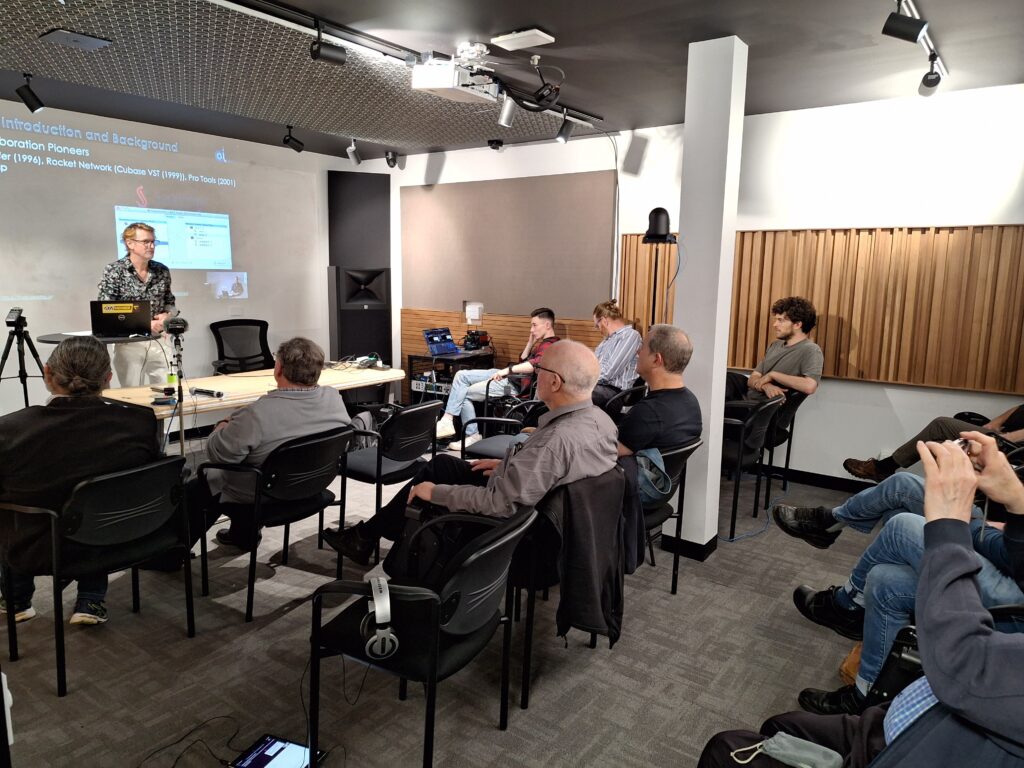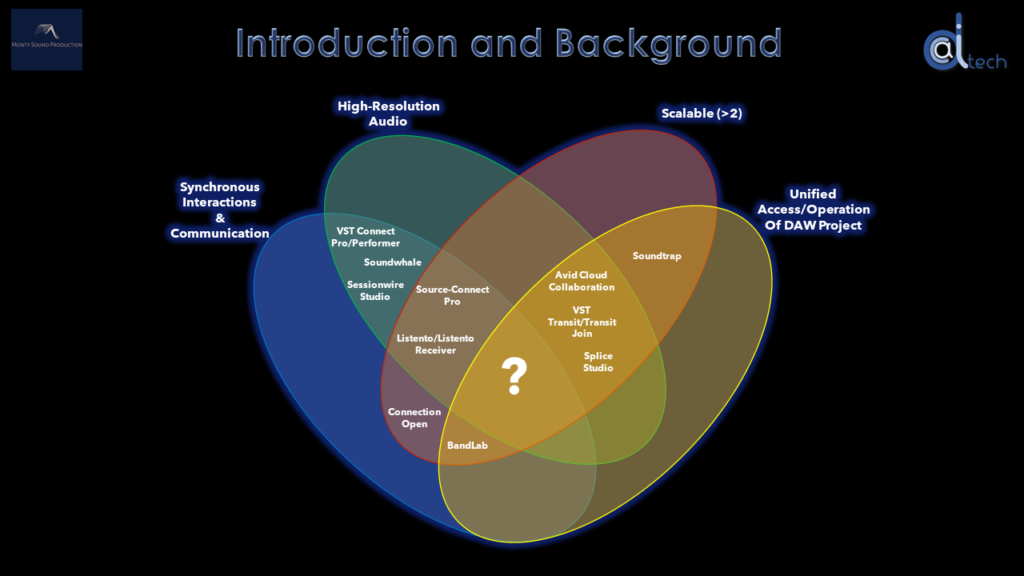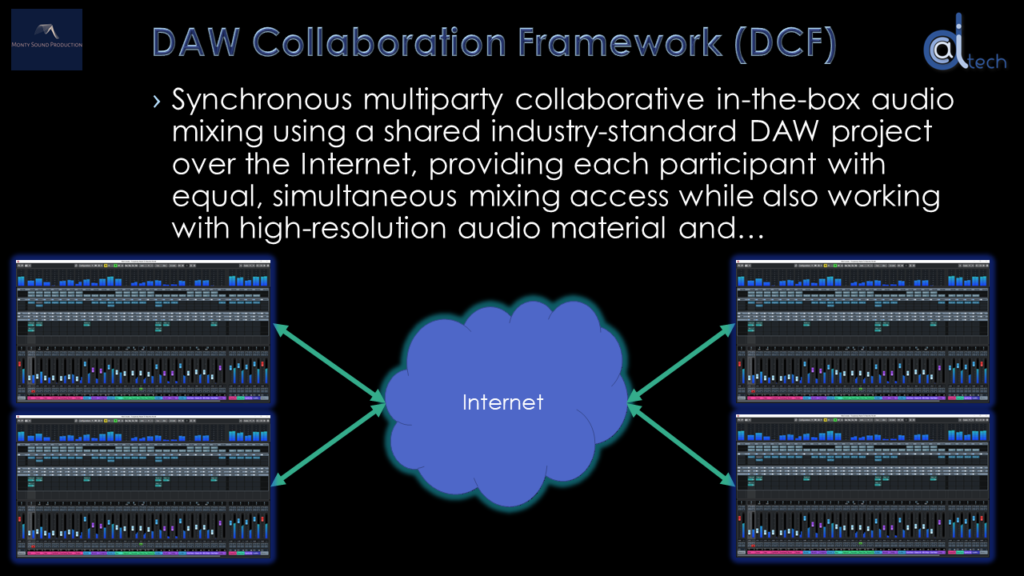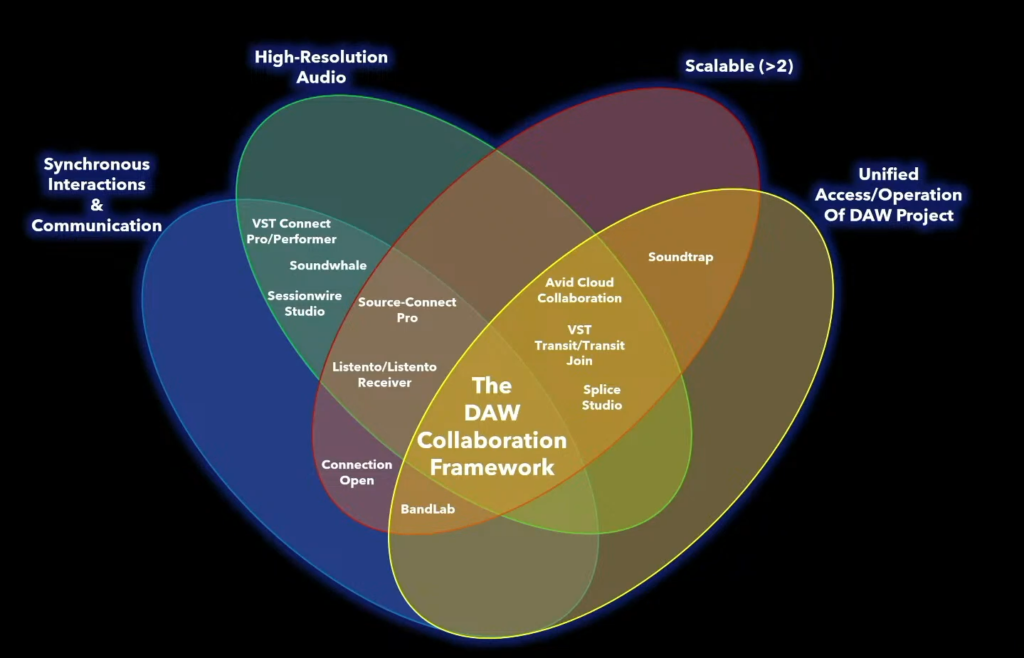On Monday 24th April, the Melbourne Section of the AES held our regular bi-monthly meeting.
It was a return to an in-person event at Collarts Wellington St (Collingwood) campus, that was also live-streamed on YouTube.
We welcomed about a dozen members and guests in the Collarts Critical Listening Room and another 7 who watched the live stream to the end.
Audio Engineer and Educator/Musician Scott Stickland presented on the topic of:
Collaborative Online Audio Mixing in the Box:
Presenting a case for the DAW Collaboration Framework
Chairman Graeme Huon introduced Scott with a brief description Scott’s work on the DAW Collaboration Framework (DCF).


Scott started by acknowledging and describing the chronology of earlier online audio collaboration technology, starting with ResRocketSurfer (1996)/Rocket Network (1999), JACK/JACKTrip, Source-Connect, Steinberg’s VST Connect Pro and VST Transit/Transit Join/Transit Go, Splice Studio, and then the push for direct streaming into the DaaAW with products like Soundwhale, Sessionwire, ConnectionOpen and Listento and the growth in web-based DAW collaboration platforms, where he commented that web audio is not at the stage of development where they can be used for professional applications.
Scott then updated us on the career of Martin Koszolko, who had presented to us on a similar topic in April 2021 (https://aesmelbourne.org.au/april2021mtg/), noting that he was now at the University of Newcastle, managing the International Collaborative Music Contest.
Scott moved on to describe his PhD project, outlining the characteristics needed for a true professional-level collaborative audio mixing, displaying a Venn diagram demonstrating that none of the previously referenced solutions fulfilled all those needs for a true real-time online collaborative mixing for professional-grade audio.

He described researching various options like Open Sound Control (OSC), Touch OSC/TouchDAW, and Video Conferencing platforms like Cisco WebEx, but none met the needs. Moving on to distributing the data online, he described how reliable multicasting really needed IPV6, which was currently not widely available for local domestic internet users. Scott told us that the solution he settled on was WebRTC, which can provide all the components for reliable videoconferencing on a Chromium-based browser.
Scott then described how he was able to come up with a solution that permitted synchronous multiparty collaborative in-the-box mixing with up to 30 participants using a standard domestic 50Mbps NBN internet connection.

Scott explained how individual Cubase DAW sessions on the participants’ computers were controlled and synchronised using virtual MIDI ports via an external utility interfacing to the DAW’s “Generic Remote” implementation, which permitted mapping features to the virtual interface. He commented that currently, virtually all DAW manufacturers have some form of user-defined MIDI controller implementation that could be used for this application. Scott explained that the MIDI mapping data is distributed to each participant as an XML file to be imported into their DAW to ensure consistent operation of the DAWs across the network.
He then went on to describe the infrastructure used a third-party cloud provider, LiveSwitch, with three Multi-point Control servers (MCUs) to enable scaling up to 30 concurrent users, with the data all routing to LiveSwitch’s Dallas servers over four hops with acceptable latency.
Scott then presented demos of some elements of a 3-way session featuring performers from Cool Change – the Ultimate LRB Tribute Band (Scott plays keyboards in this band) located in geographically spaced Melbourne suburbs.
Scott canvassed other potential applications of the DAW Collaboration Framework, suggesting Online Audio/Music Production Education, noting that current asynchronous video solutions lack interactivity and have limited audio quality.
He then re-displayed the earlier Venn diagram and proposed that the DAW Collaboration Framework successfully meets all of the four requirements outlined.

The session concluded with a Q&A session where a range of topics was canvassed including session communications and coordination, the challenges of managing Intellectual Property when working with manufacturers, and the use of MIDI playback.

We thank Scott for a most interesting and informative session.
We also thank Collarts for providing the venue, Jason Torrens (Collarts Head of Audio Production), and especially Collarts’ Will Petts who set up, configured and operated the live streaming technology.
Here’s an edited video of the YouTube stream:
This video can be viewed directly on YouTube at:
https://youtu.be/Yhoc_8JGrEg
Scott’s Slide deck in pptx format (without audio) can be viewed below:
Related Links:
Scott’s Journal Articles and Conference Papers/Presentations
A Framework for Real-Time Online Collaboration in Music Production
Design of a real-time multiparty DAW Collaboration Application using Web MIDI and WebRTC APIs
Towards a vision for a virtual DAW collaboration studio for professional post-production music projects
Design and Evaluation of a Scalable Real-Time Digital Audio Workstation Collaboration Framework
Professional Views of Digital Audio Workstations and Collaborative Audio Mixing
A new audio mixing paradigm: evaluation from professional practitioners’ perspectives
Scott’s Thesis
Online Real-Time Collaborative Audio Mixing: A New Audio Mixing Paradigm
Other Links:
JACK/JACKTrip –
https://help.jacktrip.org/ and https://ccrma.stanford.edu/groups/soundwire/software/jacktrip/
Source Connect – https://www.source-elements.com/products/source-connect/
Steinberg VST Connect Pro/Performer – https://www.steinberg.net/vst-connect/
Steinberg VST Transit/Transit Join/Transit Go – https://www.steinberg.net/vst-transit/
Splice Studio – https://splice.com/blog/announcing-splice-studio-v2/
Soundwhale – https://soundwhale.com/
Sessionwire – https://www.sessionwire.com/
ConnectionOpen – https://www.connectionopen.com/
Audiomovers – https://audiomovers.com/wp/
BandLab – https://www.bandlab.com/?lang=en
Soundtrap (by Spotify) – https://www.soundtrap.com/
Amped Studio – https://ampedstudio.com/
Dr Martin Koszolko –
https://www.newcastle.edu.au/profile/martin-koszolko
https://collaborativemusiccontest.com
Author: Peter Smerdon – Secretary

